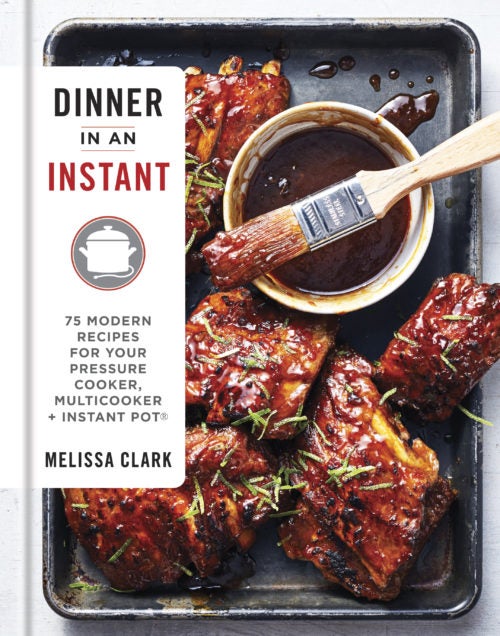


































Cassoulet, a sumptuous dish of soft, aromatic beans and meats baked under a crisp bread-crumb crust, may not be the kind of thing you’ll find in fancy French restaurants, but what it lacks in refinement it makes up for in rustic, brawny charm. Named for the earthenware pot in which it is traditionally cooked (the cassole), cassoulet has its roots in the rural cooking of the Languedoc region, where the usual meats stirred in are duck and pork. In my version, I substitute lamb, both shanks and sausages, which gives the dish a slightly more sophisticated character.
Like all cassoulets, this one does take time. You have to braise the lamb shanks, soak and simmer the dried beans, brown the sausages, then combine everything and cook it all again beneath the savory bread-crumb topping. Just give yourself up to the rhythm of roasting, sautéing, and long, slow simmering. The final stew, a glorious pot of velvety beans and chunks of tender meat covered by a burnished crust, is completely worth the effort. Then serve it with a rich red wine and a crisp green salad. You won’t need anything else to round out this hearty, meaty meal.
Thinking Ahead
Lamb: You can marinate the lamb as long as overnight, covered and refrigerated. You can braise the shanks 1 day in advance. Shred the meat, separate the sauce, and store both separately in the refrigerator. Scoop off and discard any fat that accumulates on the surface of the liquid before reheating.
Beans: You can let the beans soak, covered and refrigerated, as long as overnight. You can cook them (before adding them to the sausage mixture) up to 5 days in advance. Store the cooled and drained beans and the bean liquid in separate airtight containers in the refrigerator.
Cassoulet: You can make the cassoulet, through step 14, up to 3 days in advance. Store it, covered, in the refrigerator. Bring it to room temperature before topping it with the crust for the final baking.
Directions
- Marinate the lamb: In a small bowl, combine the salt, paprika, pepper, thyme, rosemary, and half of the garlic (save the remaining garlic for sautéing). Rub the mixture all over the lamb shanks. Place the lamb in a bowl or dish, cover it, and refrigerate for at least 4 hours or overnight.
- Soak the beans: Place the beans in a bowl and add enough cold water to cover them by 2 inches. Stir in 1 teaspoon of the salt and let them soak at room temperature for at least 4 hours or overnight.
- Heat the oven to 325°F.
- Cook the lamb: Heat the oil in a large Dutch oven over medium-high heat. Add the lamb shanks, in batches if necessary, and brown the meat all over, 3 to 5 minutes per side. Take your time with this (it will likely take 15 to 20 minutes all told); the more color you get on the meat, the richer the sauce will be. Transfer the meat to a plate as it browns.
- If the Dutch oven looks dry, drizzle in a little more oil. Add the onion, carrots, celery, remaining garlic, and a pinch of salt and sauté until the vegetables are tender and golden at the edges, 5 to 7 minutes. Add the tomato paste and harissa and cook until the pastes darken, 30 seconds to 1 minute. Add the wine to the pot and cook until it has reduced by half, 3 to 5 minutes. Add the stock and bring the liquid to a simmer.
- Return the lamb and any juices to the pot, cover, and place it in the oven. Let the lamb braise, turning it every 30 minutes, until the meat is very tender, 1½ to 2 hours.
- While the lamb braises, cook the beans: Drain the beans and place them in a pot with enough water to cover them by 2 inches; add the remaining 2 teaspoons salt. Using kitchen twine, tie the thyme sprigs, parsley sprigs, rosemary sprigs, and bay leaf into a bundle and add it to the pot (or just throw the herbs into the pot if you don’t have twine). Bring to a simmer and cook for 30 minutes.
- Add the sausage to the beans and let it poach in the bean liquid for 15 minutes (the sausage will not be fully cooked at this phase). Using tongs, transfer the sausage to a cutting board to cool slightly. Continue to cook the beans until they are tender, which can take anywhere from another 15 minutes to 2 hours, depending upon what kind you used and how fresh they were. (If the water level gets too low, add some boiling water to the pot.) Drain the beans in a colander set over a bowl to catch the liquid, and discard herbs. Reserve the bean cooking liquid.
- When the lamb shanks are cool enough to handle, tear the meat off the bones and put it in a bowl. Discard the bones or save them for stock. Use a slotted spoon to scoop out all the vegetables from the pot and add them to the lamb. Taste the cooking liquid left in the pot. If it tastes bland and seems thin and watery, simmer it on the stove until it thickens slightly, then season it to taste with salt and pepper. Transfer the liquid to a measuring cup and spoon the fat off the top. You should have between 1 and 1½ cups liquid (if it’s more than that, put it back in a small pot on the stove and reduce it a little longer; if it’s less than that, add a little more stock); reserve the liquid. Reserve the Dutch oven for baking the cassoulet (you don’t need to wash it).
- To finish the beans, heat the oil in a large skillet over medium-high heat. When the oil shimmers, add the onion, half the garlic, the pepper, and a pinch of salt. Sauté until the onion is translucent, about 4 minutes.
- Dice the reserved lamb sausage into ¾-inch pieces and add them to the skillet. Sauté until the sausage and onions are golden at the edges, 5 to 10 minutes. Add the tomato purée and simmer until the oil separates out and the sauce reduces a bit, about 10 minutes.
- Add the drained beans and the chicken stock, and simmer until the beans are moist and very soupy, 12 to 15 minutes, stirring occasionally. Add some of the reserved bean cooking liquid if the mixture dries out at any point. Stir in the remaining grated garlic, the lemon zest, and the minced parsley. Taste, and add more salt if needed.
- Turn the oven temperature up to 350°F.
- Spoon half the beans into the Dutch oven, top them with the lamb and vegetables, and then cover with the remaining beans. Pour the reserved lamb cooking liquid around the edges of the pot until it reaches the top layer of beans but does not cover them. If there’s not enough lamb liquid, add some of the reserved bean cooking liquid.
- Make the topping: Mix the melted butter, rosemary, garlic, lemon zest, and salt in a small bowl. Add the panko and use your fingers to mix in the bread crumbs well, making sure the butter is well distributed. Sprinkle the mixture evenly on top of the beans in the pot.
- Bake until the crust is very lightly browned, about 30 minutes. Use the back of a large spoon to lightly crack the crust; the liquid will bubble up. Use the spoon to drizzle this liquid all over the top of the crust. If there is not enough liquid in the pot to drizzle all over the crust, drizzle it lightly with some of the reserved bean cooking liquid. Return the pot to the oven and bake for 30 minutes to 1 hour more, cracking the crust and drizzling with the bean liquid every 20 minutes or so, until the crust is well browned and the liquid is bubbling. (The total baking time should be 1¼ to 1½ hours.) Remove the pot from the oven and let the cassoulet cool slightly, then serve.
Reprinted from Dinner in French. Copyright © 2020 by Melissa Clark. Photographs copyright © 2020 by Laura Edwards. Published by Clarkson Potter, an imprint of Penguin Random House, LLC.

